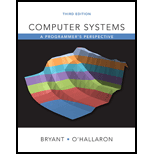
Concept explainers
Explanation of Solution
Implementation of a concurrent version of the TINY web server on I/O threads:
Modified “main.c” code:
#include "csapp.h"
//Function declaration
void doit(int fd);
void read_requesthdrs(rio_t *rp);
int parse_uri(char *uri, char *filename, char *cgiargs);
void serve_static(int fd, char *filename, int filesize);
void get_filetype(char *filename, char *filetype);
void serve_dynamic(int fd, char *filename, char *cgiargs);
void clienterror(int fd, char *cause, char *errnum,char *shortmsg, char *longmsg);
void *thread(void *vargp);
//Main function
int main(int argc, char **argv)
{
//Declare variable
int listenfd, connfd;
int *connfdp;
pthread_t tid;
char hostname[MAXLINE], port[MAXLINE];
socklen_t clientlen;
struct sockaddr_storage clientaddr;
/* Check the command line argument. if the argument does not satify, then */
if (argc != 2)
{
//Display the below error message
fprintf(stderr, "usage: %s <port>\n", argv[0]);
fprintf(stderr, "use default port 5000\n");
listenfd = Open_listenfd("5000");
}
//Otherwise,
else
{
//Call the Open_listenfd method
listenfd = Open_listenfd(argv[1]);
}
//Check condition
while (1)
{
//Get the length the client address
clientlen = sizeof(clientaddr);
//For connection accept
connfd = Accept(listenfd, (SA *)&clientaddr, &clientlen);
//Call the method
Getnameinfo((SA *) &clientaddr, clientlen, hostname, MAXLINE,
port, MAXLINE, 0);
//Display the accepted connection
printf("Accepted connection from (%s, %s)\n", hostname, port);
connfdp = (int*)Malloc(sizeof(int));
*connfdp = connfd;
//Call Pthread_create method
Pthread_create(&tid, NULL, thread, connfdp);
}
}
//Function definition for thread method
void *thread(void *vargp)
{
//Compute the connection file descriptor number
int connfd = *(int*)vargp;
//Call pthread detach method
Pthread_detach(Pthread_self());
//Free the given file
Free(vargp);
//Call doit method
doit(connfd);
//Close the connection
Close(connfd);
return NULL;
}
/* Function definition for doit method that is for handle HTTP request or response transfer */
void doit(int fd)
{
//Declare variable
int is_static;
struct stat sbuf;
char buf[MAXLINE], method[MAXLINE], uri[MAXLINE], version[MAXLINE];
char filename[MAXLINE], cgiargs[MAXLINE];
//Create object for rio function
rio_t rio;
/* Read request line and headers */
Rio_readinitb(&rio, fd);
//Check read request
if (!Rio_readlineb(&rio, buf, MAXLINE))
return;
//Display the buffer
printf("%s", buf);
//Display the parse request
sscanf(buf, "%s %s %s", method, uri, version);
//Check condition
if (strcasecmp(method, "GET"))
{
//Call client error method
clienterror(fd, method, "501", "Not Implemented","Tiny does not implement this method");
return;
}
//Call read_requestdrs method
read_requesthdrs(&rio);
/* Parse URI from GET request */
is_static = parse_uri(uri, filename, cgiargs);
//Check the static connection
if (stat(filename, &sbuf) < 0)
{
//Call client error method
clienterror(fd, filename, "404", "Not found",
"Tiny couldn't find this file");
return;
}
/* Check serve static content */
if (is_static)
{
if (!(S_ISREG(sbuf.st_mode)) || !(S_IRUSR & sbuf.st_mode))
{
//Call client error method
clienterror(fd, filename, "403", "Forbidden","Tiny couldn't read the file");
return;
}
//Call serve_static method
serve_static(fd, filename, sbuf.st_size);
}
//Otherwise check the serve dynamic content
else
{
if (!(S_ISREG(sbuf.st_mode)) || !(S_IXUSR & sbuf.st_mode))
{
//Call client error method
clienterror(fd, filename, "403", "Forbidden","Tiny couldn't run the CGI program");
return;
}
//Call serve dynamic method
serve_dynamic(fd, filename, cgiargs);
}
}
/* Function definition for read_requestdrs that is for read HTTP request headers */
void read_requesthdrs(rio_t *rp)
{
//Declare variable
char buf[MAXLINE];
Rio_readlineb(rp, buf, MAXLINE);
printf("%s", buf);
//Check condition
while(strcmp(buf, "\r\n"))
{
//Call rio readlineb function
Rio_readlineb(rp, buf, MAXLINE);
printf("%s", buf);
}
return;
}
/* Function definition for parse uri into file nane and cgi argument */
int parse_uri(char *uri, char *filename, char *cgiargs)
{
//Declare char variable
char *ptr;
//Check content type...
Want to see the full answer?
Check out a sample textbook solution
Chapter 12 Solutions
Computer Systems: A Programmer's Perspective Plus Mastering Engineering With Pearson Etext -- Access Card Package (3rd Edition)
- Information Security Risk and Vulnerability Assessment 1- Which TCP/IP protocol is used to convert the IP address to the Mac address? Explain 2-What popular switch feature allows you to create communication boundaries between systems connected to the switch3- what types of vulnerability directly related to the programmer of the software?4- Who ensures the entity implements appropriate security controls to protect an asset? Please do not use AI and add refrencearrow_forwardFind the voltage V0 across the 4K resistor using the mesh method or nodal analysis. Note: I have already simulated it and the value it should give is -1.714Varrow_forwardResolver por superposicionarrow_forward
- Describe three (3) Multiplexing techniques common for fiber optic linksarrow_forwardCould you help me to know features of the following concepts: - commercial CA - memory integrity - WMI filterarrow_forwardBriefly describe the issues involved in using ATM technology in Local Area Networksarrow_forward
- For this question you will perform two levels of quicksort on an array containing these numbers: 59 41 61 73 43 57 50 13 96 88 42 77 27 95 32 89 In the first blank, enter the array contents after the top level partition. In the second blank, enter the array contents after one more partition of the left-hand subarray resulting from the first partition. In the third blank, enter the array contents after one more partition of the right-hand subarray resulting from the first partition. Print the numbers with a single space between them. Use the algorithm we covered in class, in which the first element of the subarray is the partition value. Question 1 options: Blank # 1 Blank # 2 Blank # 3arrow_forward1. Transform the E-R diagram into a set of relations. Country_of Agent ID Agent H Holds Is_Reponsible_for Consignment Number $ Value May Contain Consignment Transports Container Destination Ф R Goes Off Container Number Size Vessel Voyage Registry Vessel ID Voyage_ID Tonnagearrow_forwardI want to solve 13.2 using matlab please helparrow_forward
- a) Show a possible trace of the OSPF algorithm for computing the routing table in Router 2 forthis network.b) Show the messages used by RIP to compute routing tables.arrow_forwardusing r language to answer question 4 Question 4: Obtain a 95% standard normal bootstrap confidence interval, a 95% basic bootstrap confidence interval, and a percentile confidence interval for the ρb12 in Question 3.arrow_forwardusing r language to answer question 4. Question 4: Obtain a 95% standard normal bootstrap confidence interval, a 95% basic bootstrap confidence interval, and a percentile confidence interval for the ρb12 in Question 3.arrow_forward
 Systems ArchitectureComputer ScienceISBN:9781305080195Author:Stephen D. BurdPublisher:Cengage LearningNp Ms Office 365/Excel 2016 I NtermedComputer ScienceISBN:9781337508841Author:CareyPublisher:Cengage
Systems ArchitectureComputer ScienceISBN:9781305080195Author:Stephen D. BurdPublisher:Cengage LearningNp Ms Office 365/Excel 2016 I NtermedComputer ScienceISBN:9781337508841Author:CareyPublisher:Cengage Programming with Microsoft Visual Basic 2017Computer ScienceISBN:9781337102124Author:Diane ZakPublisher:Cengage Learning
Programming with Microsoft Visual Basic 2017Computer ScienceISBN:9781337102124Author:Diane ZakPublisher:Cengage Learning New Perspectives on HTML5, CSS3, and JavaScriptComputer ScienceISBN:9781305503922Author:Patrick M. CareyPublisher:Cengage Learning
New Perspectives on HTML5, CSS3, and JavaScriptComputer ScienceISBN:9781305503922Author:Patrick M. CareyPublisher:Cengage Learning LINUX+ AND LPIC-1 GDE.TO LINUX CERTIF.Computer ScienceISBN:9781337569798Author:ECKERTPublisher:CENGAGE L
LINUX+ AND LPIC-1 GDE.TO LINUX CERTIF.Computer ScienceISBN:9781337569798Author:ECKERTPublisher:CENGAGE L C++ for Engineers and ScientistsComputer ScienceISBN:9781133187844Author:Bronson, Gary J.Publisher:Course Technology Ptr
C++ for Engineers and ScientistsComputer ScienceISBN:9781133187844Author:Bronson, Gary J.Publisher:Course Technology Ptr





